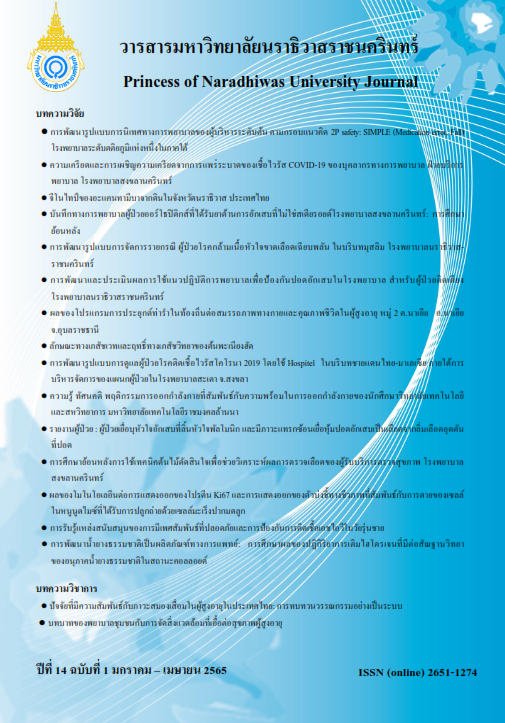The Development and Evaluation of Clinical Nursing Practice Guideline for Preventing Hospital-Acquired Pneumonia of Bedridden Patients in Naradhiwasrajanagarindra Hospital
Keywords:
Practice guideline, Hospital acquired pneumonia, Prevention bedriddenAbstract
The purposes of this study were to develop and evaluate a clinical nursing practice guideline (CNPG) for preventing hospital-acquired pneumonia of bedridden patients. The study consisted of 3 phases: 1) study and problem analysis, 2) construction and development of the nursing practice guidelines for HAP prevention and 3) evaluation. The study is a quasi-experimental research designed. The sample consisted of 39 professional nurses, 39 caregivers and 78 bedridden patients which they were categorized into the experimental and the control group. The research instrument included the nursing practice guideline (NPG) and the CNPG video for HAP prevention. The data were collected by observation form for CNPG, record form for HAP cases and satisfaction questionnaires for nurses and caregivers. Data were analyzed by using descriptive statistics, Fisher’ exact test and Wilcoxon Sign-Rank test.
The results showed that nurses had a mean score of nursing practice in bedridden patients for HAP after using the guideline than before using the nursing guideline with statistical significance
(t = 4.91, p <.001). The HAP incidence in bedridden patients before and after adopting NPG were 27 and 2 cases, respectively, with statistical significance (p <.001). Nurses and caregivers were satisfied at a high level (M = 4.19, SD = 44 and M = 2.85, SD = .32) after using the guideline.
In conclusion, it is suggested that the CNPG development should be brought to implement. Based on the evidence, this helps reduce Hospital Acquired Pneumonia of bedridden patients, and the CNPG should be expanded to caregivers for the care of bedridden patient at home.
References
American Thoracic Society. (2020). Guidelines for the Management of Adults with Hospital-acquired, Ventilator-associated, and Healthcare-associated Pneumonia. American. Journal of Respiratory and Critical Care Medicine, 171(4), 388-416.
Assawapalanggool, S., & Surimuang, M. (2020). Effectiveness of Coaching on Adherence towards Guidelines for Prevention of Ventilator-Associated Pneumonia and Clinical Outcomes. Ramathibodi Nursing Journal, 26(2), 138-154.
Boonprasert, W. (2019). Incidence and Impact of Hospital-Acquired Pneumonia in the Medical Wards at Chiangkham Hospital. Journal of Bamrasnaradura Infectious Diseases Institute, 13(1), 35-43.
Burton, L.A., Price, R., Barr, K.E., McAuley, S.M., Allen, J.B., Clinton, A.M. (2016). Hospital-acquired pneumonia incidence and diagnosis in older patients. Age and Ageing, 45(1), 171-174.
Butimal, P., Isaramalai, S., & Thaniwattananon, P. (2018). Development of Nursing Practice Guideline for Preventing Complications in Bed-Bound Elders at Home. Songklanagarind Journal of Nursing, 38(3), 79-91.
Center for Disease Control and Prevention. (2003). Guideline for preventing health - care Associated Pneumonia. MMWR Recommendations and Report, 53(1), 1-36.
Center for Disease Control. (2017). Pneumonia (Ventilator-associated [VAP] and non-ventilator-associated Pneumonia [PNEU]) Event. Device-associated Module PNEU/VAP, 1-17.
Hassoun-Kher, N., Hussein, K., Abboud, Z., Raderman, Y., Abu-Hanna, L., & Darawshe, A. (2020). Risk factors for ventilator-associated pneumonia following cardiac surgery. Journal of Hospital Infection, 105(3), 546-551.
Hirzallah, F.M., Alkaissi, A., & CéuBarbieri-Figueiredo M. (2019). A systematic review of nurse-led weaning protocol for mechanically ventilated adult patients. Nursing in Critical Care, 24(2), 89-96.
Kalil, A.C., Metersky, M.L., Klompas, M., Muscedere, J., Sweeney, D.A., & Palmer, L.B. (2016). Management of Adults with Hospital-acquired and Ventilator-associated Pneumonia: 2016 Clinical Practice Guidelines by the Infectious Diseases Society of America and the American Thoracic Society. Infectious Diseases Society of America, 63(1), 61-111.
Lertthaitrakul, W. (2011). The Deming Cycle (PDCA). Retrieved from http://business.east.spu.ac.th/ admin/waaa_file/A37322 PDCA.pdf
Medical record male internal medicine of Naradhiwas Rajanagarindra Hospital. (2018). Incident medical record Hospital Acquired Pneumonia: HAP in Naradhiwas rajanagarindra Hospital. 2016-2018.
Paksee, N., Sirapo-ngam, Y., Monkong, S., & Leelacharas, S. (2016). Effects of a Transitional Care Program for Stroke Patients and Family Caregivers on Caregiver’s Preparedness, Stress, Adaptation, and Satisfaction. Ramathibodi Nursing Journal, 22(1), 65-80.
Sirikul, T., Werathammo, A., & Khattiyamarn, W. (2016). Effects of Teaching Management with an Integration of Demonstration, Scenario, and Group Discussion on Knowledge, Skills, and Problem-Solving Regarding Emergency Medical Care Among Students of Sirindhorn College of Public Health, Yala. The Southern College Network Journal of Nursing and Public Health, 3(2), 53-69.
Sornsomnuk, S., Khuwatsamrit, K., & Monkong, S. (2017). Effects of Using Nursing Practice Guidelines for Ventilator Associated Pneumonia Prevention on the Incidence of Ventilator Associated Pneumonia. Ramathibodi Nursing Journal, 23(3), 284-297.
Srireaungrut, W (2012). Development and Evaluation of Clinical Nursing Practice Guideline for Preventing Ventilator - Associated Pneumonia in Intensive Care Unit, Hatyai Hospital.
A Thesis Submitted in Partial Fulfillment of the Requirements for the Degree of Master of Nursing science (Adult Nursing) Prince of Songkla University. (in Thai).
Taipale, H. , Tolppanen, A.M., Koponen, M., Tanskanen, A., Lavikainen, P., & Sund, R. (2017). Risk of pneumonia associated with incident benzodiazepine use among community-dwelling adults with Alzheimer disease. Canadian Medical Association Journal, 189(14), 519-529.
Teeraviroj, N., Sukphadung, S., & Sooksanit, K. (2018). Effects of the use of Guidelines for Prevention of Hospital-acquired Pneumonia for Orthopedic Patients, Buriram Hospital. Medical Journal of Srisaket Surin Buriram hospital, 33(3), 291-309.
Thamcharoentrakul, B. & Saensom, D. (2019). Effects of Using Nursing Practice Guideline for Ventilator Associated Pneumonia Prevention: Medical Department. The Journal of Baromarajonani College of Nusing, Nakhonratchasima, 25(1), 25-42.
Torres, A., Niederman, M.S., Chastre, J., Ewig, S., Fernandez-Vandellos, P., & Hanberger, H. (2017). International ERS/ESICM/ESCMID/ALAT guidelines for the management of hospital-acquired pneumonia and ventilator-associated pneumonia. European Respiratory Journal, 50, 1-26.
Vernikors, P., Kampolis, C.F., Konstantopoulos, K., Armaganidis, A., & Karakitsos, P. (2016). The Role of bronchoscopy findings and bronchoalveolar lavage fluid cytology in early diagnosis of ventilator-associated pneumonia. Respiratory Care, 61(5), 658-667.
Additional Files
Published
How to Cite
Issue
Section
License
Copyright (c) 2022 Princess of Naradhiwas University Journal

This work is licensed under a Creative Commons Attribution-NonCommercial-NoDerivatives 4.0 International License.




